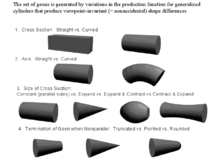Geon (psychology)
When combined in different relations to each other (e.g., on-top-of, larger-than, end-to-end, end-to-middle) and coarse metric variation such as aspect ratio and 2D orientation, billions of possible 2- and 3-geon objects can be generated.
Two classes of shape-based visual identification that are not done through geon representations, are those involved in: a) distinguishing between similar faces, and b) classifications that don’t have definite boundaries, such as that of bushes or a crumpled garment.
Because the geons are based on these discontinuities, they are invariant to variations in the direction of lighting, shadows, and surface texture and markings.
The geons constitute a partition of the set of generalized cones,[2] which are the volumes created when a cross section is swept along an axis.
Kim Kirkpatrick-Steger, Edward A. Wasserman and Irving Biederman have found that the individual geons along with their spatial composition are important in recognition.

